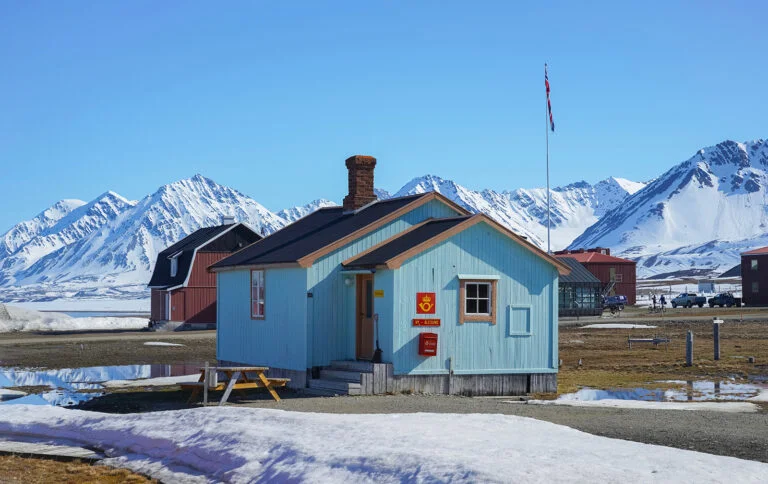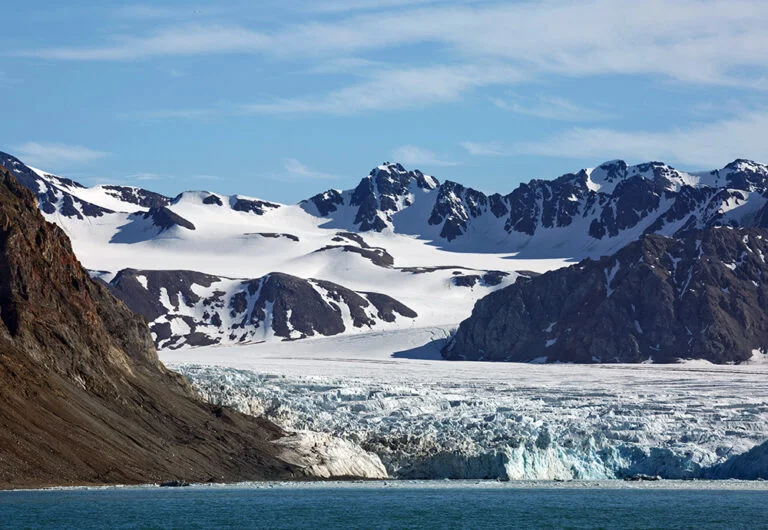The former coal mining settlement on Svalbard is now a critical research station for the international scientific community.
Welcome to Ny-Ålesund. This former mining settlement on Spitsbergen island is now home to year-round research facilities staffed by several countries.

This isn't a place many people visit. If you've ever been to Svalbard, you'll have likely stayed in Longyearbyen. The town of 2,000 people feels like a true wilderness, yet Ny-Ålesund takes things to a new level.
From mid-April to to the end of August every year, the sun never sets. The polar night period, without a sunrise, lasts from mid-November to the end of January.
Where is Ny-Ålesund?
Ny-Ålesund is located in Oscar II Land, in the northwest portion of Spitsbergen island in the Svalbard archipelago. The settlement is situated on the Brøgger peninsula about halfway along the Kongsfjord.

At 79-degrees north, Ny-Ålesund is generally referred to as the world's northernmost permanently inhabited civilian settlement. While Longyearbyen claims the title of “northernmost town,” Ny-Ålesund is actually farther north.
But despite the facilities, calling Ny-Ålesund anything more than a settlement would be a stretch. While anyone can theoretically travel to and even move to Longyearbyen, that is not the case here.
An international community
Today, long after coal mining operations ceased, Ny-Ålesund remains a company town. It is owned and operated by Kings Bay AS, which is owned by Norway's ministry of climate and environment.
Kings Bay provides facilities to support permanent research activities from various institutions. “We run the community, take care of our common cultural heritage and supply infrastructure services, but also offer other services that contribute to greater research coordination and collaboration” – Kings Bay AS.

More than 10 countries are represented in the settlement's year-round population of up to 35, a number that rises to more than 100 in the summer.
This makes for a truly international community, with researchers from China, Germany, Korea, India, Japan, France, Italy, the Netherlands and more living and working together.
The Norwegian Polar Institute plays the role of host institution, and researchers from several Norwegian institutes work here too.
Research activities in the High Arctic
Ny-Ålesund offers a unique environment for studies of climate change. It's also a key location for natural science research and environmental monitoring in the high Arctic.

There are four thematically broad ‘flagship programmes' in Ny-Ålesund, into which most research activities fall. These are atmosphere, terrestrial ecosystems, Kongsfjord system and glaciology.
In and around Ny-Ålesund
While not a town, Ny-Ålesund does have more facilities than you might expect in order to support the scientific infrastrcuture and year-round population. There are also occasional tourists, especially in the summer, but there is no infrastructure for overnight stays for tourists.
The small Ny-Ålesund airport welcomes a regular flight from Longyearbyen several times per week, although places on the flights can only be booked through the company Kings Bay.
There is a small museum showcasing the town's mining history and a post office.
But that's where the similarities with a regular town end. A small shop, Kongsfjordbutikken, sells toiletries, snacks, souvenirs, and alcohol, but it's open just a couple of hours every week.

There are no hotels or restaurants. Resident scientists take their meals in the dining mess three times per day at set times.
The mess is located in a service building, together with a reception, laundry, waste return station and medical services. Outside of this, most of the buildings are either accommodation or research infrastructure.
Radio silence
This is perhaps one of the quirkiest aspects of life in Ny-Ålesund. The settlement is a radio silent community in order to protect disruption to the highly-sensitive scientific equipment.
This means that all use of Wi-Fi and Bluetooth is not permitted. Mobile phones and other electronic equipment should be set to flight mode with Bluetooth disabled within a 20km radius of the settlement.
There is a system of wired telephones and ethernet ports for internet access throughout the settlement.
History of Ny-Ålesund
English whaler Jonas Poole discovered the coal deposits on the south side of Kongsfjorden as early as 1610. But it would take three centuries before commercial coal mining operations began.

Since 1916, Kings Bay (then KBKC) has owned and run the settlement. The firm ran the company town, which was home to up to 400 people.
In the 1920s, Ny-Ålesund became a popular base for polar exploration. In 1926, Roald Amundsen, American Lincoln Ellsworth and Italian Umberto Nobile took the Norge from Ny-Ålesund over the North Pole.
In 1928, Nobile returned with a mostly Italian crew to try again with the airship Italia, but the airship crashed onto the ice north of Svalbard.

Amundsen took part in the rescue operation but also crashed. Neither Amundsen nor the plane were ever found.
Cultural heritage of Ny-Ålesund
Kings Bay also bears responsibility for the protection of the settlement's cultural heritage. This includes many of the settlement's buildings that date back around 100 years.
Among the quirkier sights are the statue of Roald Amundsen and the original mooring mast for Roald Amundsen's airship Norge. There is also an abandoned train and railway line, formerly use to haul coal to the harbour.

Back in the coal mines, a series of fatal accidents—in 1948, 1952, 1953 and 1962—took the lives of more than 60 miners. The incidents led to the political decision to stop coal mining in 1963.
Since then, Ny-Ålesund has become a focus point for Arctic research, thanks largely to the early work of the Norwegian Polar Institute. The Norwegian Research Council (NTNF) took over the settlement, but it was returned to Kings Bay in the 1970s.


